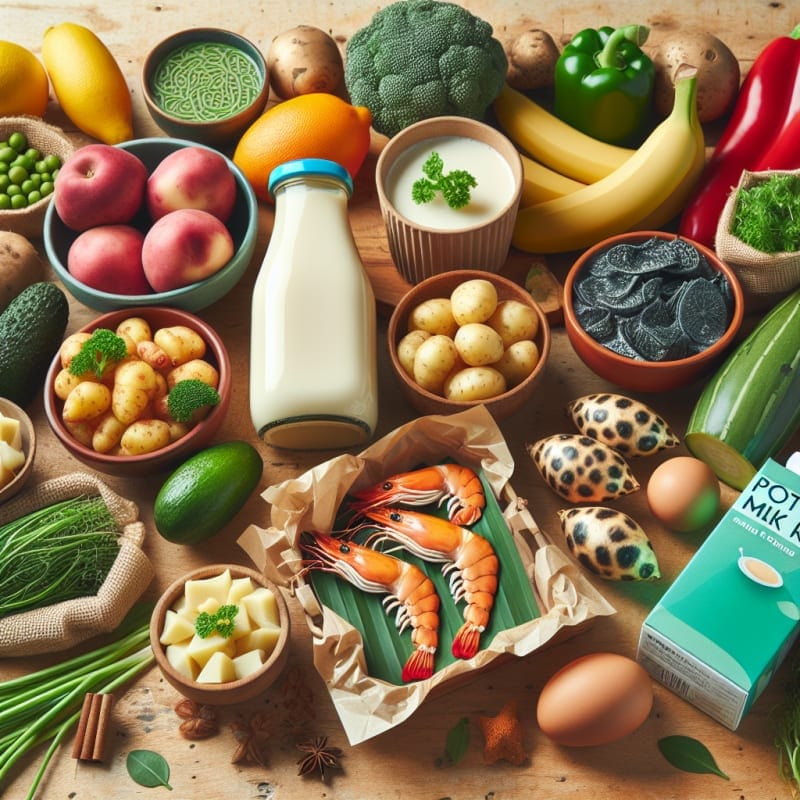Top Vegan Food Trends to Watch in 2025: From Potato Milk to Vegan Seafood
Vegan food is no longer a niche market—it’s a global movement reshaping how we eat, shop, and think about sustainability. In 2025, vegan food trends are evolving faster than ever, driven by innovation in plant-based dairy alternatives, vegan seafood, and clean-label ingredients. Consumers are demanding foods that are not only animal-free but also nutritious, affordable, and environmentally responsible.
According to VegOut Magazine and Restaurantware, 2025 marks a turning point where plant-based innovation meets mainstream adoption. Let’s explore the most exciting developments shaping vegan diets this year—from potato milk sustainability to banana blossom seafood and beyond.
1. The Rise of Potato Milk: A Sustainable Dairy Alternative
Move over oat and almond—2025 is the year of potato milk. This new plant-based dairy alternative is gaining traction for its creamy texture, neutral flavor, and low environmental footprint. Potatoes require less water and land than nuts or soy, making them one of the most sustainable crops for dairy substitutes.
| Feature | Potato Milk | Oat Milk | Almond Milk |
|---|---|---|---|
| Water Usage | Very Low | Moderate | High |
| Protein Content | Medium | Low | Low |
| Environmental Impact | Minimal | Moderate | High |
As reported by TriplePundit, potato milk is being embraced by major retailers and coffee chains for its versatility and sustainability. Brands are experimenting with fortified versions that include added calcium and B12 to match traditional dairy nutrition.
Q&A: How Sustainable Is Potato Milk?
Q: How sustainable is potato milk compared to other plant-based milks?
A: Potato milk ranks among the most sustainable dairy alternatives. Potatoes grow quickly, need little water, and can be cultivated in diverse climates, reducing carbon emissions and soil depletion.
2. Vegan Seafood Alternatives: The Ocean Without the Catch
With overfishing and ocean pollution threatening marine ecosystems, vegan seafood alternatives are becoming a cornerstone of ethical eating. Innovative products like banana blossom fish, seaweed-based tuna, and mycoprotein shrimp are redefining what seafood can be.
According to Innova Market Insights, plant-based seafood is one of the fastest-growing segments in the vegan market. These products mimic the texture and flavor of traditional fish while providing omega-3 fatty acids from algae and flaxseed sources.
- Banana Blossom Fish: A fibrous, flaky texture ideal for frying or grilling.
- Seaweed Tuna: Rich in iodine and marine minerals.
- Mycoprotein Shrimp: Made from fungi protein, offering high digestibility and taste.
Q&A: What Makes Vegan Seafood Nutritionally Balanced?
Q: How do vegan seafood products provide the same nutrients as real fish?
A: Many vegan seafood alternatives are fortified with omega-3s, vitamin D, and iodine derived from algae and seaweed, ensuring similar nutritional benefits without environmental harm.
3. Plant-Based Protein Innovation: Beyond Soy and Pea
Protein is the backbone of any diet, and vegan innovation in 2025 is expanding beyond soy and pea. New sources like chickpea, fava bean, and fermented fungi are making plant-based proteins more digestible and flavorful.
Research from Innova Market Insights highlights that consumers now prefer blends that deliver complete amino acid profiles. Fermentation technology is improving texture and taste, helping vegan proteins compete with animal-based ones in both nutrition and satisfaction.
Top Plant-Based Protein Sources in 2025
- Fava Bean Protein – high in lysine and fiber
- Chickpea Protein – smooth texture and mild flavor
- Mycoprotein – sustainable fungi-based protein
- Algae Protein – rich in omega-3s and antioxidants
4. Clean Eating and Ingredient Transparency
Consumers are demanding more transparency in what goes into their food. The clean eating vegan movement emphasizes minimal processing, short ingredient lists, and traceable sourcing. This trend is reinforced by growing awareness of allergens, additives, and environmental impact.
Apps like Food Scan Genius are helping users instantly analyze ingredients for allergens, additives, and sustainability scores. One user shared: “I use Food Scan Genius every time I shop—it’s like having a food scientist in my pocket.”
This shift toward clarity is not just about health—it’s about trust. With increasing reports of mislabeling and hidden animal derivatives, tools like Food Scan Genius empower consumers to make informed vegan choices.
Q&A: How Does Food Scan Genius Support Vegan Shoppers?
Q: What makes Food Scan Genius valuable for vegan consumers?
A: The app scans product barcodes to reveal whether ingredients are plant-based, sustainable, and allergen-free—helping users maintain clean eating habits effortlessly.
5. Vegan Fast Food and Mainstream Adoption
Fast food chains are embracing veganism like never before. From plant-based burgers to dairy-free milkshakes, 2025’s best vegan fast food options are satisfying cravings while supporting sustainability.
Restaurantware reports that major brands are expanding vegan menus to cater to flexitarian consumers. Expect to see potato milk lattes, mushroom-based nuggets, and algae-infused sauces hitting menus worldwide.
Q&A: Why Are Fast Food Chains Going Vegan?
Q: What’s driving the rise of vegan fast food in 2025?
A: Consumer demand for ethical, sustainable, and healthier options is pushing fast food giants to innovate. Vegan menu items attract younger, eco-conscious customers and reduce environmental impact.
6. Why These Trends Matter for Everyone
Even if you’re not vegan, these trends affect you. The innovations in plant-based dairy and vegan seafood are improving food sustainability, reducing carbon footprints, and inspiring healthier diets globally. As the PETA 2025 Vegan Food Trends guide notes, the line between vegan and mainstream eating is blurring—because better food benefits everyone.
FAQs About Vegan Food Trends 2025
What are the biggest vegan food trends in 2025?
Potato milk, vegan seafood, and clean-label plant proteins are leading the way, supported by sustainability and flavor innovation.
Are plant-based dairy alternatives healthier than regular milk?
Many are lower in saturated fat and cholesterol, though fortification with calcium and B12 helps match dairy nutrition.
Can vegan seafood really taste like fish?
Yes—advances in texture technology and seaweed flavoring make vegan seafood remarkably similar to traditional fish dishes.
What role does technology play in vegan food innovation?
Fermentation, AI-driven ingredient analysis, and sustainability apps like Food Scan Genius are driving smarter, cleaner food production.
Is the vegan food market expected to keep growing?
Absolutely. With major brands investing in plant-based products and consumers prioritizing health and sustainability, growth is projected to accelerate through 2030.
Conclusion: The Future of Vegan Eating
From potato milk to vegan seafood, 2025 is redefining what plant-based eating looks like. These innovations are not just about avoiding animal products—they’re about creating sustainable, delicious, and transparent food systems for everyone.
Whether you’re a lifelong vegan or simply curious, exploring these trends helps you make smarter food choices. And with tools like Food Scan Genius, understanding ingredients has never been easier. The future of food is plant-powered—and it’s already here.





